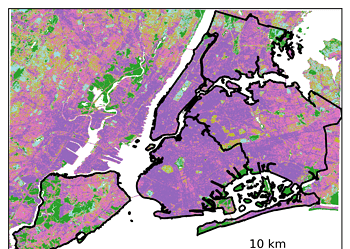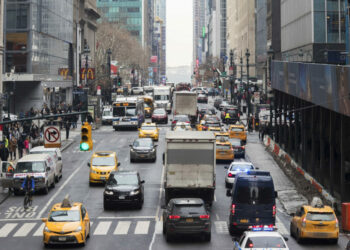New York City is literally sinking. Satellite data shows that the city is dipping one to two millimeters on average every year, with some neighborhoods doubling that figure. And while some of this is natural and some by people withdrawing groundwater, the weight of the skyscrapers is also playing a significant role, according to a new study.

The phenomenon is called subsidence, a gradual settling or sudden sinking of Earth’s surface that happens when soft sediment shifts or loads bearing down on the ground push it deeper. With the land slowly sinking, the threats already posed to New York City by rising sea levels and intense storms can get worse, the researchers warned.
“The point of the paper is to raise awareness that every additional high-rise building constructed at coastal, river, or lakefront settings could contribute to future flood risk, and that mitigation strategies may need to be included,” they wrote in the journal Earth’s Future. “The subsidence mapping concept helps to quantify the hazard.”
The risks of the skyscrapers
The over one million buildings across the five boroughs in New York City weigh about 1.68 trillion pounds, the researchers estimated. This is double the weight of all humanity combined. The team then used simulations to calculate the effects of that weight on the ground, comparing it with satellite data showing actual surface geology.
This showed that subsidence rates in NYC are between one and two millimeters per year, reaching up to four in some areas. While this may not sound like much, when accumulated year after year, it becomes significant. While the world’s sea levels have risen 0.5 inches per decade, New York City had a faster rate of about 1.2 inches per decade.
Hurricane Sandy in 2012 and Hurricane Ida in 2021 caused substantial damage in NYC due to flooding, wind, and heavy rainfall. These two storms, when combined, resulted in the loss of numerous lives. A study found that the city stands as the world’s third most vulnerable to coastal flooding in terms of assets that are likely to be exposed in the future.
The new estimates only consider the mass of buildings and their contents, excluding the roads, sidewalks, bridges, railways, and other paved areas. However, these new calculations improve previous observations of subsidence in the city by considering the surface geology beneath New York, which consists of sand, silt, and clay lake deposits.
While the study focuses on New York City, the problem is much more extensive. A quarter of Indonesia’s capital, Jakarta, could be underwater by 2050, studies have found. It’s been described as the world’s most rapidly sinking city. This happens mainly because of uncontrolled groundwater extraction as well as the rising Java Sea.
“Major cities on every continent except Antarctica are observed to be subsiding, and the issue may be worsened as populations grow,” the researchers wrote. “Increasing urbanization will likely exacerbate subsidence by groundwater extraction and/or construction density, which combined with accelerating sea level rise implies a growing flood hazard.”
The study can be accessed here.






